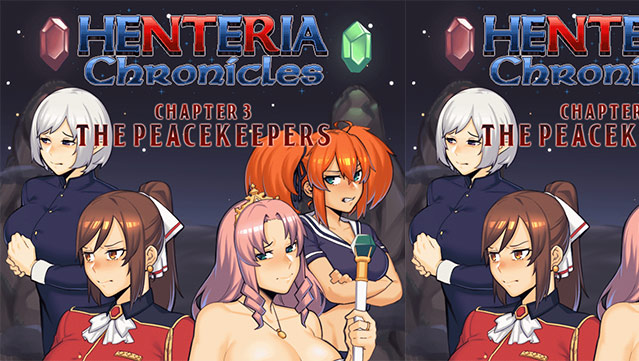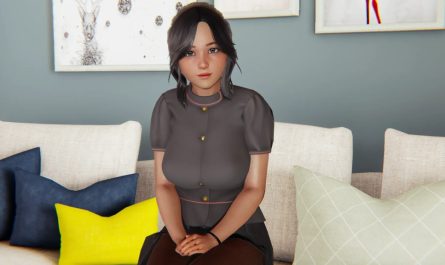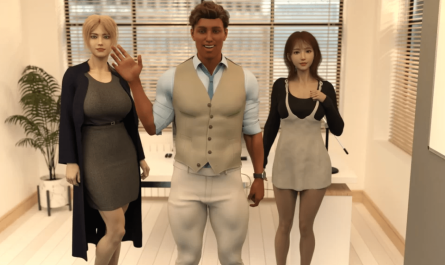[ad_1]
That’s why I wrote a little Q&A going over the main questions one could have about the game, to give you a better idea of whether it’s worth trying out or not. And more.
1. Do I have to play the games in order?
Absolutely not. Think of every game as a short story within a book that would be called “Henteria Chronicles”, with Henteria being the world they take place in.
Each and every game can be enjoyed as a standalone, a story within a story. The only things you might miss are a few lore elements to connect the dots with some of the NPCs’ dialogues, or a few cameos with characters from previous games that will have you scratch you head for a few seconds over their cryptic dialogue, referring to a story you might not have played. But apart from that, 99% of the game can be fully enjoyed without any prior knowledge of other Henteria games.
2. What’s the gameplay like?
While HC1 and HC2 had a few minigames here and there, HC3 has none. It mainly works as a VN, although I recently saw someone had tried to register HC2 on the Visual Novel Database (vndb), and it got rejected with the description being “[HC2 is] not a VN [but] an adventure game with no narration”. HC3, unlike HC1 and 2, does have narration though, although pretty scarce.
Basically, you walk around the map, talk with people, do different straightforward actions, and progress the story that way. The progression is very linear, with choices that influence your ending but don’t lead to branching paths. The main storyline will deal with the two main characters (Rose and Cyanna), and there are two optional side storylines with Lily and Haylen as their focus.
There is also an entirely optional card game similar to FF8’s Triple Triad that, at the end of the game, should have over 100+ original cards added to the game. The card game can be ignored, but you will miss a minor storyline with a minor character.
There are also two different PoV’s the players can choose from.
3. Different PoV’s?
Yes. Players can either choose from the Omniscient PoV or the Partial MC PoV at all times in the game’s main menu.
Omniscient PoV: For those who have played HC1, HC2 or Merry H-Mas, this won’t change much. The player is perceived as an omniscient being that can see all scenes and hear most thoughts, without the MC even being there.
Partial MC PoV: This one is specific to HC3. It is mainly aimed at those who would rather the NTR happen mostly “behind closed doors”, and rely on their imagination. It will focus mainly on the MC and what he sees. If he doesn’t see a sex scene, it will be skipped over, with just a few hints to let players know it is happening even if they’re not seeing it.
However, it is called “partial” for a reason. Players will still be able to see all free roam events happening all over the map, will hear sounds and see shadows that the MC cannot. They will also see all story-related events, so they can still make sense of it and aren’t completely lost.
As said above, the POV can be changed at all times during the game.
4. If the game plays “like a Visual Novel”, why RPGMaker?
Well, I feel RPGMaker is the most adequate engine for the game I wish to create. It handles pixel art well, and it is well-suited for semi-open world games. My game relies 99,5% on pixel art for its graphics, and is designed to be enjoyed as an open world.
What I aim for when developing my games is what I call “ambience NTR” or “immersion NTR”, meaning that it isn’t merely a straightforward story and visuals slapped over it, but also free roam scenes and sex events you might stumble upon while walking around the world. Shadows behind a curtain, sex in an obstructed dark alley, condoms on the ground or discarded items of clothing, faint panting sounds behind a door, bed creaking and moans on the other side of the wall, those are among the subtle sex elements you can discover as you explore the map on different timeframes, during the day or at night.
There are also a few “NTR mini-stories” involving random NPCs taking place all over the map, that will progress without player interactions. If you’re careful and enjoy exploring, you might witness different stages of those stories, or only a few of them, or miss them entirely. This will help reinforce the feeling that the world is alive in the background, without the MC.
5. How does the card game play?
The plugin I am using for the card game was made by someone no longer working on it, and it contains a few issues I had to work around. The main one being that there are no limitations on the strength of the cards you can use during a duel, which means players could just go around and beat a few stronger players, receive strong cards, and simply use them all in the same duel to steamroll all their opponents.
As a counter-measure against this, I had to streamline the duels, meaning that players will have to defeat a predetermined opponent before moving on to another stronger predetermined one, and this for the whole game. With every win, they will receive a predetermined card. This allows me to keep track of the overall deck strength of players, and make sure that their next opponent has a matching deck that can provide at least a little bit of a challenge.
6. What role do the choices fulfill in this game?
The game will keep track of what choices the player has made each time, and will trigger the appropriate ending at the end of the game. For example, if a player went for a majority of “Revenge” choices during the game, then they will get the Revenge Ending. Same for NTR and Happy Endings.
Lastly, players will have the option to have the choices either remain entirely white, or be colored, blue for NTR, red for Revenge and green for Happy. That way, they can always go for the choices related to the ending they wish to see.
(A save will be provided at the beginning of each ending, so that players won’t have to replay the entire game to see all of them).
7. What if I don’t like NTR?
HC3 (as well as HC1 and HC2) are designed in such a way that it allows players to distance themselves from the NTR if they wish to, mainly by not identifying with the MC being NTR’d. How?
Well, there are a number of small tricks, such as not giving the MC a voice, but make him speak through speech bubbles, which dehumanizes him and makes it easier for people not to associate with him. Other tricks include not being able to name the MC, so players see him less as someone they impersonate but more of a story character they control. The NTR being unavoidable is part of said tricks too, so no one feels like they chose it out of their own volition, it just happened instead.
Etc…
“Yes, but what if I really don’t like NTR?”
Well, in that case, the NTR can be made entirely avoidable by not playing the game.
9. What’s your definition of the NTR used in the game?
At this point, there are almost as many definitions for NTR that there are stars in the sky, and even Japanese players argue about what it really means, so I’ll write down what I consider to be NTR to avoid any further confusion (and possibly low reviews because “iT’s NoT nTr”, but they will still happen either way).
For me, NTR can happen with anyone the MC shares a strong bond with, not only lovers, partners, wives, etc… It could be a really good friend, a close family member, or anything that fits the description. When this bond is severed, or replaced by an even stronger bond caused mainly by manipulation and sexual corruption of the woman by the antagonist, that’s NTR. Here, that’s the general definition I use for the NTR in my games.
11. Update schedule?
I’m aiming for around 1 update per month. With HC1 and 2, I would release it every month on the exact same day without fail. For HC3, due to the higher workload it requires, I would allow myself 3-4 days delay if necessary.



